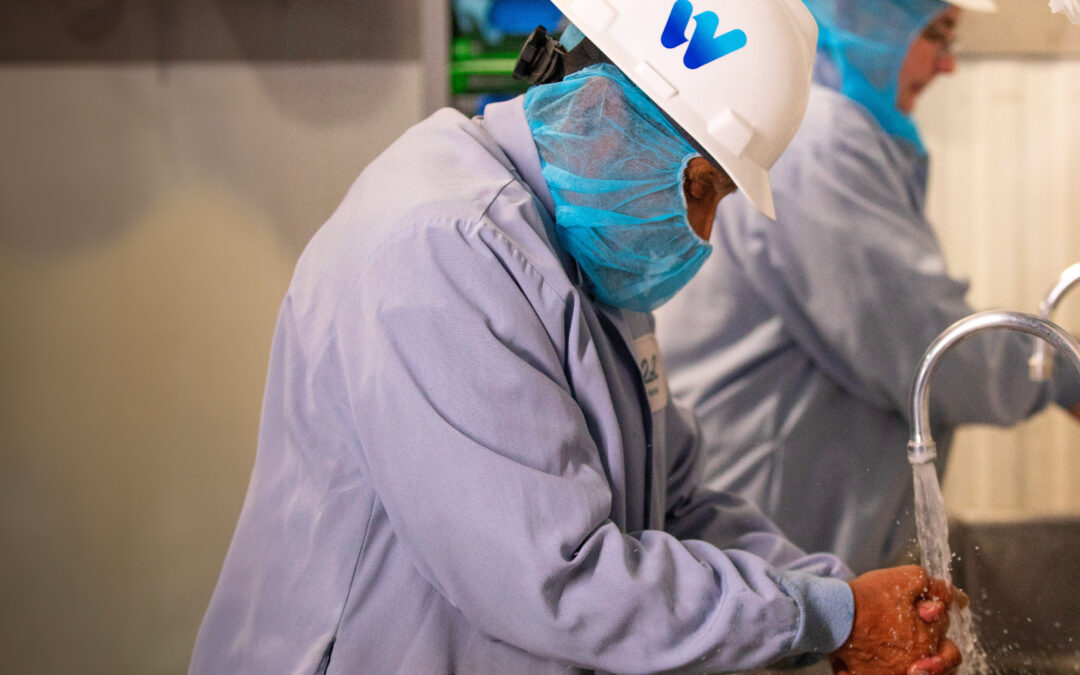SAFE FOOD is one of our three focus areas. Safe people in safe facilities produce safe food. This is achieved through practices that prevent cross-contamination and food-borne illness, closely following cleaning and sanitization procedures, and thorough quality assurance practices. When these practices are followed, we maintain high-quality food, a thriving business, and a trustworthy reputation ~ all of which aid in taking care of our team.
Food Safety vs. Food Defense: Protecting Public Health and Your Company’s Future
Food safety and food defense are two critical pillars in maintaining the integrity of a food manufacturing facility. Still, while both aim to prevent food adulteration, they focus on different threats. Food safety addresses the prevention of unintentional contamination through proper hygiene, handling, and storage practices. Food defense, however, involves safeguarding against deliberate, malicious acts of contamination intended to cause harm to consumers, employees, or the business.
This month, we explore the importance of food safety and food defense and how these strategies protect public health and preserve your company’s future.
Food Safety: Preventing Unintentional Risks
Food safety protocols are designed to prevent the unintentional adulteration of food products by controlling hazards such as bacteria, viruses, toxins, and allergens. These measures are necessary to protect consumers from foodborne illnesses and contamination.
This can be achieved through:
- Proper sanitation and hygiene practices.
- Temperature controls for safe food storage and handling.
- Regular inspections and compliance with safety regulations like our GMPS
Food safety is about minimizing the risk of accidental contamination at every stage of food production, from raw materials to finished products.
Food Defense: Preventing Intentional Acts of Harm
On the other hand, food defense is centered around preventing deliberate, intentional adulteration of food, often to cause harm. Acts of bioterrorism or sabotage are real threats to the food industry, and a breach in food defense could result in catastrophic consequences for public health, business reputation, and employee livelihoods.
One key strategy in food defense is controlled access to different areas of the facility. Employees are often granted access only to the areas necessary for their work, which minimizes the potential for unauthorized personnel to tamper with food products or introduce harmful substances. For instance, while food safety measures focus on cleanliness and hygiene, food defense measures include security protocols such as employee access control, surveillance systems, and background checks.
Restricted Access: Strengthening Food Defense
Limiting access to certain areas of a food plant is essential to food defense. For example, only specific employees may be permitted to go where food is stored, processed, or packaged. This restriction reduces the risk of intentional contamination by ensuring that only trusted, trained individuals have direct contact with food products.
Areas such as loading docks, chemical storage rooms, and ingredient preparation zones have different levels of access for various employees. For instance, production workers may be restricted from storage areas where sensitive ingredients are kept, while warehouse employees may be limited from entering the food preparation zones.
Food defense protocols can more effectively mitigate the risk of intentional harm by controlling who has access to what areas. A strong food defense plan includes access logs, monitoring systems, and clear guidelines that specify which employees are allowed in certain areas. This practice significantly reduces the risk of intentional tampering and helps maintain the integrity of the food supply.
The Potential Consequences of a Breach
A breach in food defense can have far-reaching implications. If an intentional adulteration incident occurs, it can lead to:
- Widespread illness or harm to consumers.
- Massive recalls cost the company millions in lost revenue and litigation.
- Sullied reputation, making it difficult for the company to regain consumer trust.
- Potential shutdowns by regulatory agencies, further halting operations.
- Threats to jobs, as a company facing severe financial losses may be forced to downsize or even close.
- Damage to industry relationships, as other businesses may be reluctant to collaborate with or supply to a company that has experienced such a breach.
A company’s reputation takes years to rebuild after an intentional contamination incident. Consumers and industry partners will associate the company with the incident, even after remedial actions are taken. Additionally, regulatory authorities like the FDA or USDA may impose stricter oversight, increasing operational costs and complicating processes.
Beyond this, a breach in food defense endangers the livelihood of every employee. An incident could lead to job losses, reduced wages, or even the facility’s closure. Therefore, food defense is not just about protecting the consumer but also about safeguarding the company’s future and the employees who depend on it.
Conclusion: A Shared Responsibility
Both food safety and food defense are essential for any food company. While food safety ensures that unintentional errors do not result in contaminated food reaching the consumer, food defense protects against malicious acts that could compromise the health of consumers and the company’s future.
By restricting access to sensitive areas within the plant, monitoring potential vulnerabilities, and implementing comprehensive food defense protocols, companies can minimize the risks of deliberate contamination. The result is a safer food supply and a more secure and resilient company where employees, customers, and partners can trust in the integrity of operations.
Adopting these measures is an investment in public health and the business’s long-term success. It ensures that consumers and employees remain safe and confident in the food products being produced.

